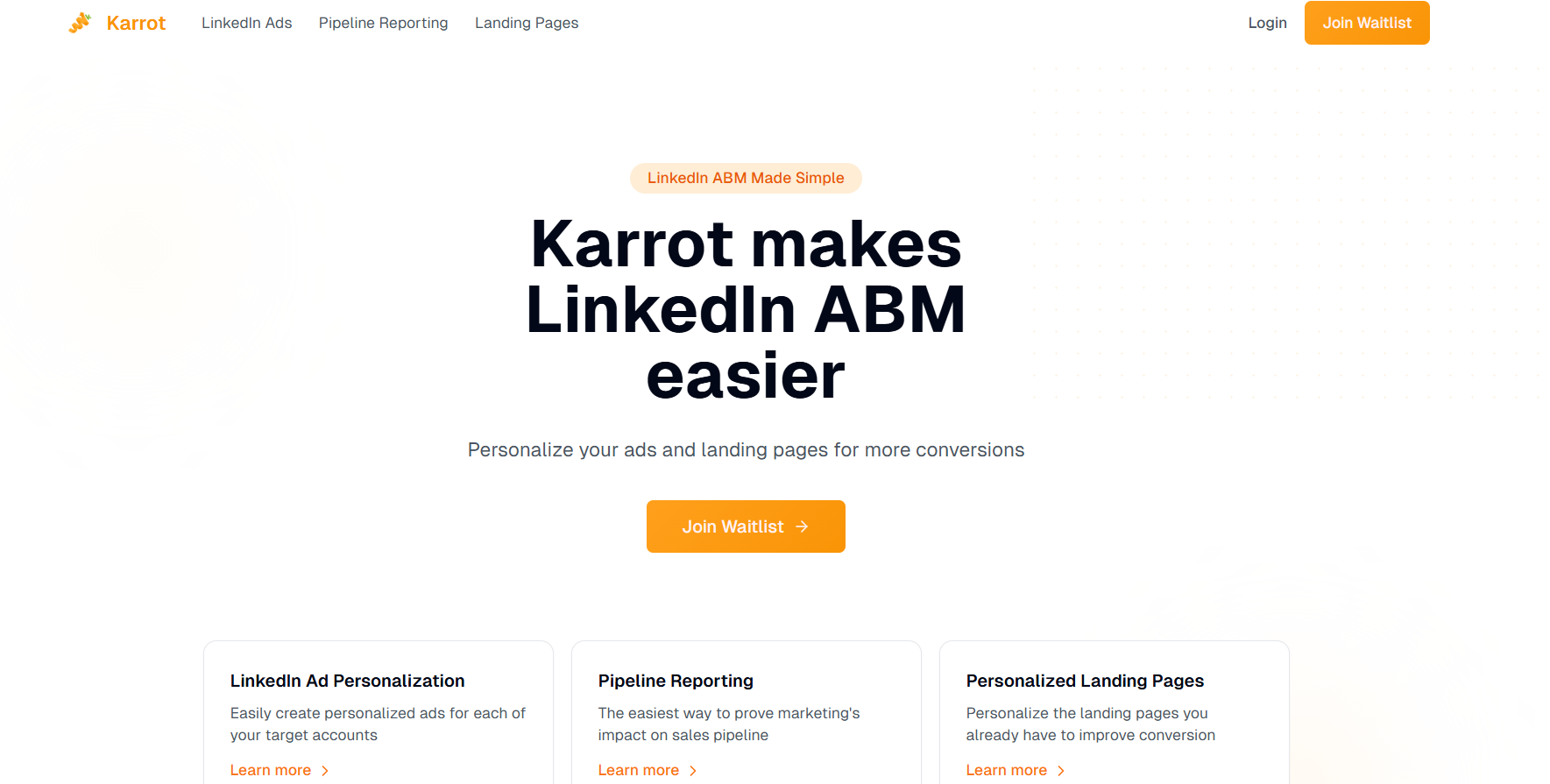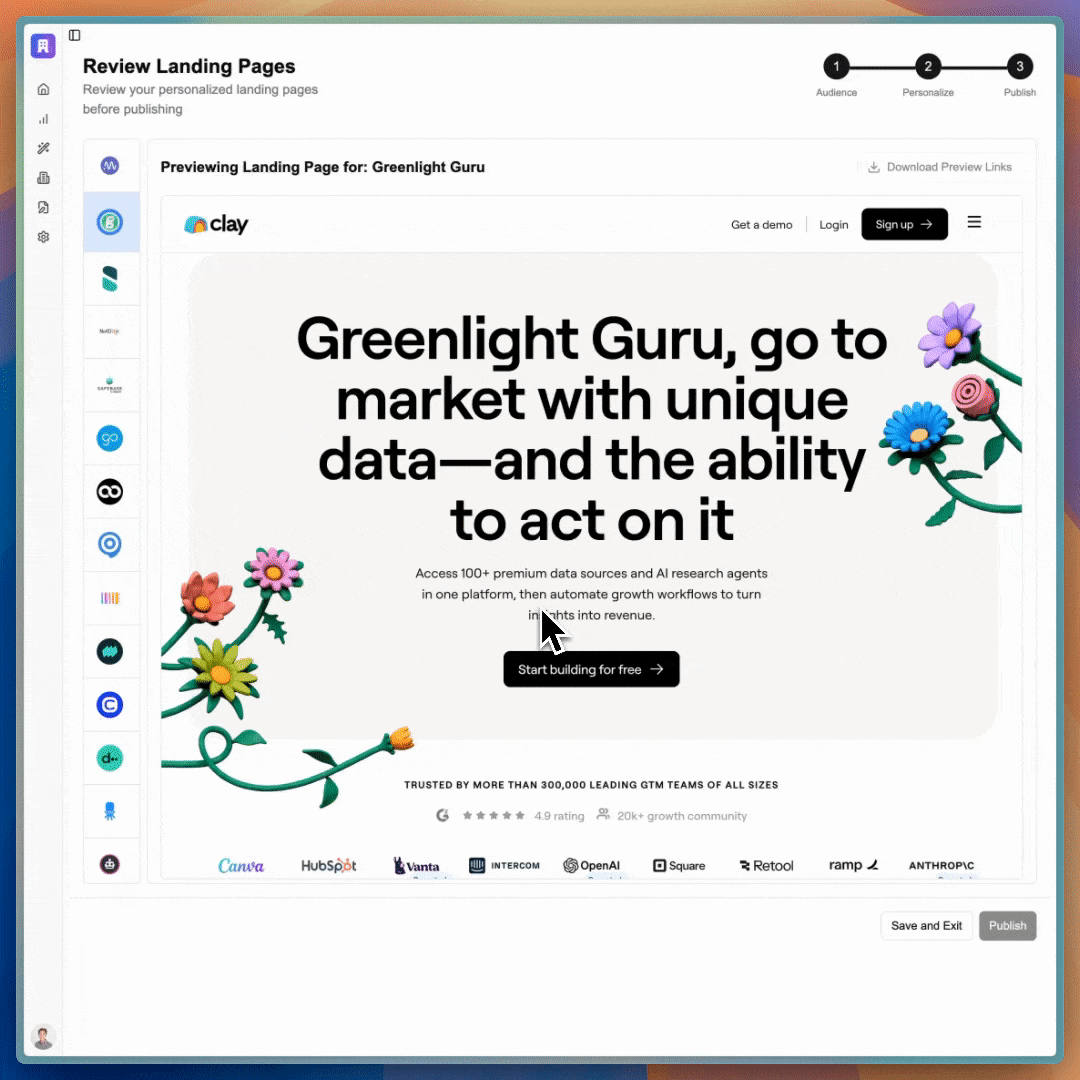How to Track AI LinkedIn ABM Attribution Across Touchpoints
67% of brands have an ABM strategy, but this created a critical challenge: most B2B teams struggle to connect every touchpoint to actual revenue outcomes. The result? Massive budgets are allocated to campaigns with unclear ROI and missed opportunities to accelerate deal velocity.
Multi-touch attribution in LinkedIn ABM isn’t just about tracking clicks anymore; it’s about understanding how AI-personalized ads, landing pages, and sales sequences work together to push prospects through complex B2B buying journeys. With buying committees involving multiple stakeholders and extended sales cycles, accurate attribution has become the key to scaling successful campaigns and avoiding wasted marketing dollars.
Ready to transform your ABM attribution strategy? Get Your Free ABM Audit to explore your options and discover how industry leaders are achieving measurable pipeline acceleration.
TABLE OF CONTENTS:
- Our 2025 Attribution Platform Evaluation Methodology
- 2025 LinkedIn ABM Attribution Platform Comparison
- 1. Karrot.ai - Best Overall LinkedIn ABM Attribution Platform ⭐
- Additional LinkedIn ABM Attribution Platforms
- Strategic Implementation Framework for 2025
- Advanced Attribution Strategies for Complex B2B Sales
- Key Performance Indicators for Attribution Success
- Emerging Trends in AI Attribution for 2025
- Making Your Attribution Platform Decision
- Accelerating Your LinkedIn ABM Attribution Strategy
- Related Video
Our 2025 Attribution Platform Evaluation Methodology
We analyzed leading AI-powered LinkedIn ABM attribution platforms using a comprehensive framework designed to identify solutions that deliver measurable business impact. Our evaluation prioritized platforms that address the core challenge facing B2B marketers: proving and improving the connection between LinkedIn engagement and revenue outcomes.
Primary evaluation criteria included:
- Multi-touch attribution accuracy: Ability to track and assign credit across LinkedIn ads, website visits, email sequences, and sales interactions
- AI-powered personalization integration: Native support for dynamic creative optimization and account-specific messaging
- Pipeline attribution capabilities: Direct integration with CRM systems for closed-loop revenue tracking
- Real-time optimization features: Automated campaign adjustments based on attribution insights
- Implementation complexity: Time-to-value for B2B marketing teams without extensive technical resources
- Proven ROI demonstration: Documented case studies showing measurable deal velocity improvements
Our analysis acknowledged that while many platforms offer basic LinkedIn tracking, few deliver the sophisticated attribution modeling required for complex ABM programs. We focused on solutions that enable marketing teams to answer critical questions: Which LinkedIn touchpoints accelerate deals? How do personalized campaigns influence buying committee engagement? What attribution model best reflects our actual sales process?
2025 LinkedIn ABM Attribution Platform Comparison
| Platform | Best For | Attribution Models | LinkedIn Integration | Starting Price | Setup Time |
|---|---|---|---|---|---|
| Karrot.ai | Comprehensive ABM Attribution | Multi-touch, Position-based, Custom | Native + API | Custom Quote | 2-3 weeks |
| HockeyStack | SaaS Companies | Multi-touch, Time-decay | API Integration | Contact for Pricing | 4-6 weeks |
| Factors.ai | Enterprise Analytics | Position-based, Linear | Limited | Custom Quote | 6-8 weeks |
| ZenABM | Small-Medium Business | First-touch, Last-touch | Basic Integration | Contact for Pricing | 1-2 weeks |
| Fibbler | Intent Data Integration | Multi-touch | Manual Setup | Contact for Pricing | 3-4 weeks |
1. Karrot.ai – Best Overall LinkedIn ABM Attribution Platform ⭐

Karrot.ai emerges as the clear leader in AI-powered LinkedIn ABM attribution, combining sophisticated multi-touch modeling with native LinkedIn automation and personalization capabilities. Unlike traditional attribution platforms that bolt on LinkedIn tracking, Karrot.ai was built specifically for the unique challenges of B2B account-based marketing.
Core Attribution Capabilities:
Karrot.ai’s attribution engine addresses the fundamental challenge facing ABM teams: connecting personalized LinkedIn campaigns to actual pipeline acceleration. The platform’s multi-touch attribution model assigns credit across every touchpoint while maintaining account-level visibility essential for ABM success. This means marketing teams can finally answer whether their AI-personalized LinkedIn ads are actually shortening sales cycles or just generating vanity metrics.
The platform’s standout feature is its position-based attribution model specifically calibrated for B2B buying journeys. Karrot.ai automates this sophisticated credit assignment while providing granular insights into which creative variations, audience segments, and campaign sequences drive the highest-value opportunities.
AI-Powered Personalization Integration:
What sets Karrot.ai apart is the seamless integration between attribution tracking and AI-driven personalization. The platform automatically creates personalized LinkedIn ads for each target account, then tracks how these customized touchpoints influence engagement and pipeline progression. This closed-loop approach enables continuous optimization based on actual attribution data rather than surface-level metrics.
The platform’s AI engine analyzes attribution patterns to identify which personalization variables correlate with faster deal velocity. Marketing teams receive actionable insights into which approaches drive the strongest results for their specific market and buyer personas.
Pipeline Attribution & CRM Integration:
Karrot.ai’s HubSpot integration provides accurate closed-loop attribution by connecting LinkedIn engagement data directly to pipeline opportunities and closed-won revenue. The platform tracks not just marketing-qualified leads but actual deal progression, enabling teams to optimize for business outcomes rather than vanity metrics.
Case study results demonstrate this focus on business impact. A B2B software company using Karrot.ai achieved measurable pipeline acceleration through precise attribution tracking and AI-powered optimization, directly attributing a significant portion of their influenced pipeline to their LinkedIn ABM efforts within six months.
Real-World Performance:
A software company implemented Karrot.ai’s enterprise-grade attribution capabilities. After deploying comprehensive multi-touch tracking across LinkedIn ads, website engagement, and CRM data, 42% of their closed-won deals were influenced by LinkedIn marketing, and those deals were 161% larger on average. This level of attribution enabled this company to increase LinkedIn ABM investment with a clear ROI justification dramatically.
Implementation & Support:
Despite its sophisticated capabilities, Karrot.ai maintains a no-code implementation approach that enables marketing teams to deploy attribution tracking without extensive technical resources. The platform’s 2-3 week setup process includes dedicated onboarding, custom attribution model configuration, and integration with existing marketing technology stacks.
Pricing & Investment:
Karrot.ai uses custom pricing based on account volume, attribution complexity, and integration requirements. While this represents a premium investment compared to basic tracking tools, the platform’s focus on measurable business outcomes typically delivers ROI within the first quarter of implementation.
Discover how Karrot.ai can accelerate your growth. Get Your Free ABM Audit to discuss your specific needs and attribution challenges.

Additional LinkedIn ABM Attribution Platforms
2. HockeyStack – Best for SaaS Companies
HockeyStack specializes in attribution for B2B SaaS companies with strong multi-touch modeling capabilities. The platform excels at tracking LinkedIn ad performance across freemium and trial conversion funnels, making it particularly valuable for product-led growth companies.
Strengths: Comprehensive SaaS metrics, strong API integrations, detailed cohort analysis
Limitations: Less sophisticated personalization features, longer implementation timeline
Best for: SaaS companies with existing attribution infrastructure seeking LinkedIn-specific enhancements
3. Factors.ai – Best for Enterprise Analytics
Factors.ai offers enterprise-grade attribution analytics, providing robust support for complex, multi-stakeholder B2B buying journeys. The platform’s strength lies in its advanced statistical modeling and integration with business intelligence tools.
Strengths: Advanced statistical modeling, enterprise security, comprehensive reporting
Limitations: Limited LinkedIn-specific features, complex setup process, and higher technical requirements
Best for: Large enterprises with dedicated data science teams and complex attribution requirements
4. ZenABM – Best for Small-Medium Businesses
ZenABM offers accessible attribution tracking for smaller B2B teams without extensive technical resources. The platform focuses on essential attribution features with streamlined setup and affordable pricing.
Strengths: Quick implementation, affordable pricing, user-friendly interface
Limitations: Basic attribution models, limited personalization features, and fewer integration options
Best for: Small-medium B2B companies seeking basic LinkedIn attribution without complexity
5. Fibbler – Best for Intent Data Integration
Fibbler combines LinkedIn attribution with third-party intent data to provide comprehensive account intelligence. The platform excels at identifying which accounts are showing buying signals across multiple channels.
Strengths: Strong intent data integration, account-level scoring, sales alignment features
Limitations: Manual setup requirements, limited automation, basic reporting
Best for: Companies prioritizing intent data and sales-marketing alignment
Strategic Implementation Framework for 2025
Successfully tracking AI LinkedIn ABM attribution requires more than just selecting the right platform. Based on analysis of high-performing ABM programs, here’s the proven implementation framework that leading B2B companies use to achieve measurable attribution accuracy:
Phase 1: Attribution Model Selection
Select your attribution model based on the actual complexity of your sales process. Position-based models are most effective for longer B2B sales cycles, while time-decay models better reflect shorter, more transactional processes. Most successful implementations start with position-based attribution and refine based on initial data insights.
Phase 2: Data Integration Architecture
Establish clean data flow between LinkedIn Campaign Manager, your chosen attribution platform, CRM system, and any intent data providers. This integration foundation determines attribution accuracy and actionability of insights.
Phase 3: Account-Level Tracking Setup
Configure account-level engagement tracking to capture interactions with the buying committee, rather than just individual lead behavior. This requires mapping multiple contacts to parent accounts and weighting engagement based on role seniority and buying influence.
Phase 4: Baseline Measurement & Optimization
Establish baseline metrics before launching AI-powered campaigns, then continuously optimize based on attribution insights. An enterprise demonstrated this with Karrot.ai, achieving $12.4 million in influenced pipeline after only six months.
Need help choosing the right partner? Get Your Free ABM Audit to get personalized recommendations for your specific attribution challenges and business objectives.
Advanced Attribution Strategies for Complex B2B Sales
The most sophisticated ABM programs go beyond basic multi-touch attribution to implement advanced strategies that capture the nuanced reality of B2B buying processes. These approaches require more sophisticated platforms but deliver significantly more actionable insights.
Buying Committee Attribution:
Rather than tracking individual leads, advanced attribution maps engagement across entire buying committees. This approach recognizes that B2B purchases involve multiple stakeholders and assigns credit based on role influence and engagement timing. Platforms like Karrot.ai excel at this committee-level attribution by connecting LinkedIn engagement patterns to actual decision-maker influence.
Intent-Weighted Attribution:
Sophisticated programs combine LinkedIn engagement data with third-party intent signals to create weighted attribution models.
Predictive Attribution Modeling:
AI-powered platforms now offer predictive attribution that identifies accounts likely to convert based on engagement patterns, enabling proactive campaign optimization. This approach shifts from reactive reporting to predictive optimization, allowing marketing teams to influence outcomes in real-time.
Key Performance Indicators for Attribution Success
Effective LinkedIn ABM attribution measurement requires focusing on metrics that directly correlate with business outcomes rather than vanity metrics. Based on analysis of high-performing ABM programs, here are the essential KPIs that drive meaningful optimization:
Pipeline Velocity Metrics: Track how LinkedIn touchpoints influence deal progression speed. Measure time-to-opportunity, opportunity-to-close ratios, and stage progression rates for LinkedIn-influenced deals versus baseline.
Account Engagement Depth: Monitor buying committee engagement breadth and frequency. High-performing programs track engagement across multiple stakeholders within target accounts rather than focusing solely on individual lead behavior.
Attribution-Driven ROI: Calculate return on ad spend using multi-touch attribution rather than last-click metrics. This provides a more accurate assessment of LinkedIn’s actual influence on pipeline and revenue.
For additional insights into comprehensive ABM measurement, explore our detailed guide on understanding LinkedIn ABM pipelines from setup to performance tracking, which covers advanced pipeline attribution strategies.
Emerging Trends in AI Attribution for 2025
LinkedIn ABM attribution continues evolving rapidly, with several key trends shaping platform capabilities and strategic approaches for 2025:
Real-Time Attribution Optimization: Leading platforms now offer real-time campaign adjustments based on attribution insights, enabling immediate optimization rather than monthly reporting cycles.
Cross-Channel Attribution Integration: Sophisticated attribution now encompasses LinkedIn, email sequences, website behavior, and sales interactions in unified models that reflect actual B2B buying journeys.
AI-Powered Creative Attribution: Advanced platforms track which creative variations, personalization elements, and messaging frameworks drive the highest attribution scores, enabling continuous creative optimization.
Learn more about cutting-edge developments in our comprehensive analysis of AI-driven ABM innovations and emerging trends in AI-powered ABM.
Making Your Attribution Platform Decision
Selecting the best LinkedIn ABM attribution platform requires striking a balance between immediate needs and long-term growth objectives. Most successful implementations prioritize platforms that offer both sophisticated attribution capabilities and seamless integration with existing marketing technology stacks.
For enterprise B2B companies seeking comprehensive attribution with AI-powered personalization, Karrot.ai delivers the most complete solution. The platform’s native LinkedIn integration, advanced multi-touch modeling, and proven ability to demonstrate measurable business impact make it the strategic choice for teams serious about attribution-driven optimization.
Companies with simpler attribution requirements or smaller budgets may find success with specialized platforms, such as ZenABM for basic tracking or Fibbler for intent data integration. However, these solutions often require additional tools and integrations to achieve comprehensive attribution visibility.
For teams looking to maximize their LinkedIn ABM investment with sophisticated attribution and AI-powered optimization, explore comprehensive strategies in our guide to using LinkedIn account-based marketing for maximum reach.
Accelerating Your LinkedIn ABM Attribution Strategy
The attribution platform you choose will significantly impact your ability to prove and improve LinkedIn ABM performance. Companies that implement sophisticated attribution tracking achieve measurably higher marketing ROI, faster deal velocity, and more predictable pipeline generation.
Success requires more than just selecting a platform. It requires strategic implementation, continuous optimization, and alignment between marketing and sales teams based on attribution insights. The most successful ABM programs treat attribution as a competitive advantage, not just a reporting requirement.
For organizations ready to transform their LinkedIn ABM attribution strategy and accelerate deal velocity through AI-powered personalization, professional guidance can dramatically reduce implementation time and improve outcomes. Get Your Free ABM Audit to discuss your specific challenges and discover how industry leaders are leveraging advanced attribution to drive measurable business growth.





